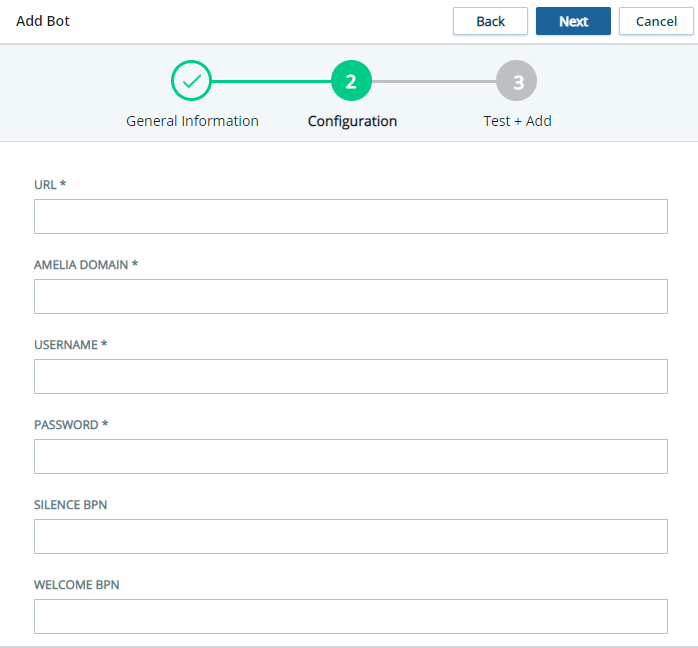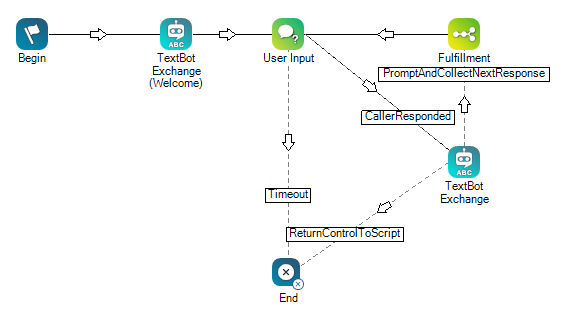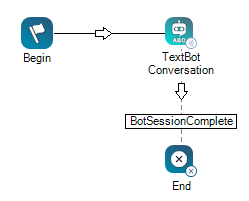CXone SmartAssist by Amelia provides conversational virtual agents for voice and chat interactions. SmartAssist virtual agents understand complex interactions and respond to them with human-level comprehension. They can replace live agents to handle customers' questions and solve problems.
CXone SmartAssist uses Amelia, an industry-leading AI bot solution. You can integrate SmartAssist with CXone using a supported Studio action![]() Performs a process within a Studio script, such as collecting customer data, playing a message or music, or routing a contact to an agent. in your scripts.
Performs a process within a Studio script, such as collecting customer data, playing a message or music, or routing a contact to an agent. in your scripts.
To use voicebots with SmartAssist, contact your CXone Account Representative. Voicebot setup happens outside of Virtual Agent Hub and requires custom scripting.
Conversation Flow for Voice and Chat
During a chat interaction, the textbot action used in the script acts like a bridge between CXone and Amelia. It passes replies back and forth between the script and Amelia. Amelia analyzes the contact's messages to understand their reasons for contacting your organization. When the conversation is complete, or if at any point the contact needs a live agent, Amelia lets the textbot action know. The Studio script continues, transferring the contact to a live agent if needed.
During a voice interaction, a Placecall action calls Amelia. A Link action then connects the contact to the Amelia voicebot. During the conversation, Amelia analyzes the contact's responses and handles the back and forth flow of the conversation. When the conversation is complete, or if at any point the contact needs a live agent, Amelia passes the contact back to the Studio script via an API signal call. The Studio script continues, transferring the contact to a live agent if needed.
Set Up SmartAssist for Chatbots
- Add the SmartAssist app to Virtual Agent Hub and configure it,
- Configure Amelia with the knowledge and information it needs to handle conversations for your organization the way you want it to.
- Add the virtual agent action that offers the functions you require to your script.
- Assign the SmartAssist bot to the action in your script.
- Customize your script as needed using Snippet actions.
CXone SmartAssist Configuration for Chatbots
When adding a SmartAssist bot to a supported Studio action in your script, you need to provide the following configuration information.
| Field | Details |
|---|---|
| URL | Your organization's URL for Amelia. Your CXone Account Representative will provide this to you. |
|
Amelia Domain |
Your organization's business sector, such as banking, healthcare, and so on. This determines the kind of information Amelia is trained with. |
| Username | The user name your organization uses to log into Amelia. |
| Password | The password your organization uses to log into Amelia. |
| Silence BPN | The name of the Business Process Network (BPN) that you want Amelia to use when it detects silence or no input from the user. For example, CustomerSilence. |
| Welcome BPN | The name of the BPN that contains the welcome message you want Amelia to use to start conversations. For example, CustomerWelcome. |
Scripting Guidelines
Before integrating a virtual agent![]() A software application that handles customer interactions in place of a live human agent., you need to know:
A software application that handles customer interactions in place of a live human agent., you need to know:
- Which script you want to add a virtual agent to.
-
The Studio actions
 Performs a process within a Studio script, such as collecting customer data, playing a message or music, or routing a contact to an agent. you need to use for your bot.
Performs a process within a Studio script, such as collecting customer data, playing a message or music, or routing a contact to an agent. you need to use for your bot. - Where the Studio actions must be placed in your script flow.
- The configuration requirements specific to the virtual agent you're using.
- How to complete the script after adding the virtual agent action. You may need to:
- Add initialization snippets as needed to the script using Snippet actions. You can do this to customize your bot.
- Re-configure the action connectors to ensure proper contact flow and correct any potential errors.
- Use the OnReturnControlToScript branch to handle hanging up or ending the interaction. If you use the Default branch, your script may not work as intended.
- Complete any additional scripting and test the script.
Ensure that all parameters in the Virtual Agent Hub actions you add to your script are configured to pass the correct data. See the online help topic for the action you're using for information about how to configure each parameter.
If you need assistance with scripting in Studio, contact your CXone Account Representative, see the Scripting Reference Material sections of the online help, or visit the NICE CXone Community site.
Supported Studio Actions for Chatbots
Textbot Exchange Action
This action is for complex bots or for when you need to customize the bot's behavior from turn to turn.
TextBot Exchange monitors the conversation between the contact and the bot![]() Virtual agent designed to handle specific interactions turn by turn. It sends each utterance
Virtual agent designed to handle specific interactions turn by turn. It sends each utterance![]() What a contact says or types. to the bot. The bot analyzes the utterance for intent
What a contact says or types. to the bot. The bot analyzes the utterance for intent![]() What the contact wants to communicate or accomplish and context and determines which response to give. TextBot Exchange returns the bot's response to the contact. When the conversation is complete, the action continues the script.
What the contact wants to communicate or accomplish and context and determines which response to give. TextBot Exchange returns the bot's response to the contact. When the conversation is complete, the action continues the script.
Textbot Conversation Action
Textbot Conversation interacts directly with the bot, passively monitoring the conversation in real time. The bot analyzes the conversation for intent![]() What the contact wants to communicate or accomplish and context and returns appropriate responses to the contact. When bot indicates that the conversation is over, the action continues with the Studio script. The action passes along any relevant information for screenpops, agent routing, and so on.
What the contact wants to communicate or accomplish and context and returns appropriate responses to the contact. When bot indicates that the conversation is over, the action continues with the Studio script. The action passes along any relevant information for screenpops, agent routing, and so on.
Textbot Conversation is not recommended for use with SmartAssist.
Amelia Configuration
You need to configure Amelia and train it to handle interactions the way you want it to. All customization of your SmartAssist virtual agent takes place in the Amelia administration pages. This is where you can:
- Create and Manage Business Process Networks (BPNs)—BPNs allow you to teach Amelia the processes you want it to follow when conversing with contacts. They define the various responses contacts may give and how you want Amelia to handle each one. BPNs provide information Amelia can use to determine the contact's intent and goals. They also specify what information or data Amelia needs to capture to complete a task, such as the contact's name and address.
- Create and Manage Intents—Intents are the goals contacts have when they contact your organization. For example, contacts might want to open an account or schedule an appointment.
- Provide and Manage Knowledge and Semantic Memory—Amelia requires a thorough database of information that it can use during conversations. It needs information about your organization and your business domain. You need to provide as much information as possible. Amelia can use many sources of information. You can upload sources such as FAQs, lists of questions and answers, blog articles, Wiki pages, and so on.
All information about configuring Amelia is available in the Amelia documentation. Your CXone Account Representative can provide you a link and information about logging in to access the documentation.




